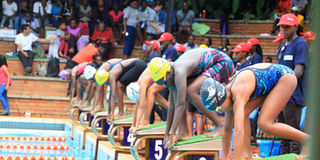How Covid-19 has made life difficult for swimmers

Action time. Swimmers prepare for the dip at the 2018 USF National Age Group Championships. Photo by Makhtum Muziransa
Have you ever imagined how swimmers, their coaches or lifeguards can keep four metres apart because social distancing measures to combat the spread of Covid-19 demands so? The option is tight and cane be the difference between life and death in water given the setup of the facilities and nature of interaction in these facilities.
If a swimmer cries out for help, a lifeguard races to the rescue and before they reach the water, the coronavirus risk calculation begins.
Every lifeguard or coach knows that to save a life, they could lose their own that the person they are trying to rescue can potentially pull them down. But now they have to worry about Covid-19 too.
When we swim out to a victim in distress, it depends on their condition. If they can manage, we will hand them a flotation device for them to hold onto and then we can swim them into shore while keeping a safe distance.
But if they’re in dire condition and cannot keep themselves afloat, we’re going to have to make direct contact with them and secure them.
The lifeguards or coaches have to undergo training to better manage their roles in relation to Covid-19 guidelines for what is the ideal new norm.
Coaches and Lifeguards are used to going up close and touching while talking to people who need their help in the pools. We’ve to slow that down now.
At the end of the day, there are going to be times when they have to get really up close, but there are lots of ways to minimise the impact.
In response to the pandemic, we shall take new suggested guidelines which are recommendable, among others, to avoid touching other people, including fellow coaches and lifeguards, unless necessary.
It does not ensure prevention of disease transmission, but lessens the likelihood.
Universal precautions should include at a gloves, N95 or recommended masks, and eye protection.
Many of these are common basic recommendations that have been in place even before the Coronavirus pandemic when HIV and other communicable diseases were and still the main threats.
Most of us who grew up watching Baywatch might be surprised to find out that lifeguards rarely have to rescue people from the water and that the biggest part of their job is preventing people from getting into trouble.
Another question is about swimmers safety if the supervision is under threat. Will protection be the norm to the guarded water bodies and non-guarded facilities when lockdown is uplifted?
Up in the (lifeguard) towers, they are self-isolated from the public so the personal protective equipment (PPE) is optional, but we have facilities and swimming coaches teaching on the pool side close to the swimmer with less than two-meter distance.
In an emergency, all aquatic victims are assessed from a two-metre distance from which we can determine whether this is a life, or non-life-threatening emergency.
If there is an immediate emergency, coaches or lifeguards will have to wear gloves, masks and eye protection, break the social distance and make contact. But this will have to be a risk taken carefully with discipline and precautions.
We don’t want to risk the chance of exposure to swimmers, coaches or lifeguards unless it is absolutely necessary.
Aquatic facilities can concentrate on better incident management practices by being more proactive and efficient with the Covid-19 guidelines while still giving the best possible care to their clients.
Lifeguards, coaches in the water coordinate closely with ambulance service, Police, fire rescue teams and now the Covid-19 Task Force to make sure they are on deck or beaches ready to provide first aid and referrals once the stricken swimmer is brought to shore.
Coaches and lifeguards in the water will have to use hand signals to communicate with the team waiting on the deck or beach, with social distancing the use of hand signs as mode of communication will have to be taught and be popular to all parties.
The challenges in implementing Covid-19 measures are many in aquatics. When pools or aquatic facilities open, and among them is the social distancing in water yet the water is one of the high risk medium of Covid-19 transmission.
This will remain a challenge and an option for one to either expose themselves or others to the risk of Covid-19 or wait until the respiratory disease is completely defeated.
Even before the pandemic, lifeguards and coaches were taking preventative steps against communicable diseases like not using mouth-to-mouth resuscitation, updated CPR sSkills, but the challenges will be access to aquatic non-contact life-saving equipment to ensure
blowing of air into the victim’s lungs (BVM-breathing ventilation mask) which every coach and lifeguard must have.
Every aquatic facility is advised to have a post-lockdown recovery plan, Covid-19 prevention plan, and facility hygiene on site for the aquatic department.
This requires training and sensitising all staff, especially those working with beaches, pools, spa, steam, sauna, health clubs and water parks.
Shortfalls from the above will pose more risks and hinder authorisation from authorities to resume normal business as water and other facilities that bring people together in a moisturised environment are some of the biggest medium of Covid-19 transmission and infections.
George William Mukasa
Aquatics Consultant
[email protected]




